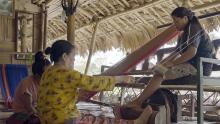History
News
15 Apr 2024
Once a two-armed attendant to the goddess Tara, over time, Marichi was increasingly endowed with power until she became a deity in her own right. Revered as a warrior and guardian against evil and darkness, Marichi’s imagery reveals myriad symbolisms — from her association with the sun to her role as a fierce protector. Read about the multifaceted nature of Marichi's mythology and imagery, spanning nations, cultures, and time.
01 Apr 2024
In India’s dry, western-most state — Rajasthan — the gods are carried from village to village, and tales that surround the deity are narrated so that the devout may be blessed. The gods are housed in a ‘kavad’, a portable shrine adorned with intricate narrative paintings of folk tales and epics. Constructed from low-density wood and painted with mineral-derived pigments, the kavad serves as a conduit for the oral storytelling tradition known as kavad banchana. Learn about the synergy between the makers, painters and patrons of these shrines, and how this tradition continues to evolve.
29 Mar 2024
Asia Research News monitors the latest research news in Asia. Some highlights that caught our attention this week are spiders that join together to transform into a flower, birds giving the right of way, and a potential natural treatment for hair loss.
19 Mar 2024
In the late 1930s, French archaeologists discovered a large and remarkable group of ivory sculptures, in Afghanistan's Begram (present-day Bagram). Stipulated to have been used as accents or embellishments for wooden furniture, these carved objects showcase a blend of Greco-Roman, Central Asian, Mediterranean, and Indic stylistic influences. Despite the political upheavals in the region, some of these ivory artefacts still survive. Explore how ongoing scholarly efforts shed light on the historical significance of these art objects, highlighting the cultural connections that were built and flourished along the Silk Road.
31 Jan 2024
Lingnan University is honoured to receive a generous donation of HK$3.88 million from the Lingnan Education Organization (LEO) to support the commencement of the two-year LingArt Programme on the Promotion & Inheritance of Chinese Culture (LingArt Programme). It aims to promote Chinese culture and show its grandeur and uniqueness through a series of cultural and artistic activities, so as to foster a deeper understanding of the rich and diverse heritage of China in both local and international students, as well as to nurture a sense of national belonging in local students.
23 Jan 2024
To strengthen connections with alumni and showcase the university's rich history and accomplishments, Lingnan University in Hong Kong has initiated a series of alumni interview activities. The first session, led by Prof S. Joe Qin, President and Wai Kee Kau Chair Professor of Data Science of Lingnan University, featured a conversation with distinguished alumnus and renowned economist Prof Gregory Chow Chi-chong in the US.
12 Jan 2024
Asia Research News monitors the latest research news in Asia. Some highlights that caught our attention this week are how a King Kongesque ape went extinct, how antibodies can make you dizzy, and a material that can break down harmful chemicals using the sun.
05 Jan 2024
Asia Research News monitors the latest research news in Asia. Some highlights that caught our attention this week are self-sacrificing cancer cells, tiny new drones that kill cancer cells and a living “skin” that covers the Great Wall of China.
06 Nov 2023
Since the 3rd century CE, master puppeteers of southern India have brought the epics of the subcontinent to life through Tholu Bommalata, a form of shadow puppetry performed with elaborate, life-sized leather puppets. Come discover this intricate musical theatre tradition that has been passed down from generation to generation and continues to thrive to this day.
20 Oct 2023
The Cholamandal Artists' Village was established in 1966 to encourage self-sufficiency, community living and the creation of a South Indian visual identity. Since then, it has undergone a transformative journey. Discover its history and achievements.
09 Oct 2023
Between the seventh and ninth centuries, south peninsular India experienced a cultural renaissance, resulting from the extensive patronage of a powerful dynasty, the Pallavas. Discover their unique contributions to the arts and literature of the time, which led to the creation of a new, Dravidian idiom of temple architecture in South Asia.
06 Oct 2023
Asia Research News monitors the latest research news in Asia. Some highlights that caught our attention this week are the confirmation of a route that humans took to migrate from Africa, how pheromones can influence beetle behavior, and microplastics found in cloud water.
24 Sep 2023
Amidst the political tumult of nineteenth-century colonial India, Abanindranath Tagore — an artist from Bengal — set out to invent a new ‘Indian’ visual language, rejecting European artistic ideals. He pioneered a style that combined themes from mythology, history, and rural life, with elements from India’s miniature painting traditions. This would evolve into the Bengal School — a movement that reimagined a distinctly Indian approach to art. Tagore influenced an entire generation of artists and left a lasting impact on the quest for Indian identity during the struggle for Independence.
13 Sep 2023
Oriental literature in general, Vietnamese literature in particular, has many types of values, perspectives, new identities and unique similarities. Read on to explore......
11 Sep 2023
In the mid-sixteenth century, Mughal emperor Humayun brought two Persian master painters to India, who not only established an imperial atelier but also began a major tradition of miniature painting in South Asia — Mughal manuscript paintings. This painting tradition flourished for centuries, enjoying royal patronage and resulted in the illustration of significant literary texts, scriptures, biographies, dynastic histories and scientific literature. Known for their naturalism and intricacy, Mughal paintings also combined a range of influences — Persian, Indian and European — and were often made collaboratively by artists and other specialists in the imperial ateliers, known as kitabkhanas. Discover the legacy and lasting influence of this painting tradition and its eventual decline in the late eighteenth century.
28 Aug 2023
Traditionally woven in Gujarat, India, mashru — meaning ‘lawful’ or ‘permitted’ in Arabic — was invented to allow Muslims to wear silk garments despite injunctions against it in the Hadith, an important Islamic religious text offering teachings and moral guidance. The fabric’s innovative weaving technique, where each silk warp crosses six cotton wefts, keeps silk from touching the body when worn. Whilst the earliest visual references to mashru date back to the seventeenth-century in the Deccan region of southern India, the fabric has lived many lives, gaining popularity amongst Islamic populations in India, West Asia and Africa as it was traded along Indian Ocean maritime routes.
18 Aug 2023
Asia Research News monitors the latest research news in Asia. Some highlights that caught our attention this week are vegan 3D printed calamari rings, 4 000-year-old ceramic pipes and ditches, and how swirling stars make some rethink how gravity works.
14 Aug 2023
In the early seventeenth century, a new painting tradition — characterised by its use of bold colours, gilding and gem-setting — emerged in the Thanjavur region of southern India. While Thanjavur paintings originally featured gods and saints, the tradition grew to incorporate secular subjects owing to a range of influences over the next several centuries, including Mughal, Maratha, and European art. Thanjavur paintings continue to be popular as memorabilia and worship objects, and are one the most recognisable South Indian painting styles today.
14 Aug 2023
Greetings from JHSSR, Horizon is proud to announce the highly acclaimed publication of the latest issue of 2023, Vol. 5, Issue 1 (Jul. 2023).
The issue is now live at the Journal’s webpage. You may explore our range of contributions within this Issue. Explore this issue, click the links below.
11 Aug 2023
Asia Research News monitors the latest research news in Asia. Some highlights that caught our attention this week are particle pollution linked to antibiotic resistance and microplastics being found in the body, fossils that show a marine reptile that used filter feeding, and how a connection in our brains compares our rewards to ones that others received.
04 Aug 2023
Asia Research News monitors the latest research news in Asia. Some highlights that caught our attention this week are how the tobacco plant could be used to help treat cancer, how lifting weights is good for your skin, and a glue that can be switched on and off.
31 Jul 2023
Backstrap looms are portable weaving contraptions with a component that is tied around the weaver’s waist, thereby engaging the weaver’s entire body in the process of creating textile out of warp and weft. Historical and archaeological evidence suggests that these looms, which presumably date as far back as the Bronze Age in China, have been, and continue to be, used by indigenous communities worldwide.
28 Jul 2023
Asia Research News monitors the latest research news in Asia. Some highlights that caught our attention this week are a powerful telescope that can catch rogue planets, a new dinosaur species found in Thailand, and 600-million-year-old water droplets.
25 Jul 2023
Miyako Islands are home to various native species of snake and lizards. How these species came to call these islands home has long puzzled scientists. A group of researchers from Tohoku University have compiled the latest geological and biological data, proposing that an island once facilitated migration between Okinawa and Miyako Islands.
25 Jul 2023
Illuminating the molecular ballet in living cells, Charting the voyage of marine plastics, A glimpse into the origins of life & Earliest human journeys to Asia. Plus Submissions open for Asia Research News 2024. Read all in the latest Editor's Choice.
19 Jul 2023
From big, permanent structures within imambaras to palm-sized ones made of cigarette boxes and coloured paper, tazias are replicas of the tomb of Imam Hussain which play a significant role in the rituals observed during Muharram. They were initially popularised by the Mughals for those royals who were unable to visit the actual tomb but the tradition continues, even today, when photographic images of the tomb are widely available — as a mode of creative expression or, perhaps more, as a performance of homage.
04 Jul 2023
The use of veterinary antibiotics is not uncommon in the fields of animal husbandry and fisheries to speed up growth and prevent disease. However, residual antibiotics may damage human gut microbiota, promote antibiotic resistance, and even delay the growth and development of brain cells, posing hazards to human health.
03 Jul 2023
Comprising over 750 rock shelters — of which over a hundred are painted — the Bhimbetka caves are perhaps the earliest known repository of art in South Asia. These prehistoric paintings illustrate hunting scenes as well as scenes of collective rituals and processions. Although their purposes remain unknown, Bhimbetka paintings provide immense historical information about humans, animals and their relationship with nature and culture.
29 Jun 2023
New technological development has provided further clues about the origins of life on Earth. An international research group invented an innovative X-ray spectroscopy approach that enabled them to recreate the chemical reactions occurring in liquids at the femtosecond level (a quadrillionth part of a second). They used this to examine ureas—an organic compound that underwent ionization to form some of the building blocks of life.
Events
Sorry, no events coming up for this topic.
Researchers
Doctoral Student 博士生, Faculty of East Asian Studies, Ruhr-Universität Bochum 波鴻魯爾大學東亞學系 (Germany)
Trần Thị Vân Dung was born in Vietnam in 1978. In 2006, she graduated from Hue University with a Bachelor of Pedagogy in Linguistics. In 2013, she received a Master of Vietnamese Literature from the University of Sciences, Hue University. Currently, she is undertaking a Ph.D. course in Vietnamese Literature at Hanoi National University of Education, Vietnam.
She has been the principal lecturer at Thua Thien Hue Pedagogical College since 2013. She sits on the reviewer board of Horizon Journal of Humanities & Social Sciences Research, a prominent scholarly peer-reviewed leading journal.
Southeast Asia Media Studies Association
University professor with 20 years of experience in Thailand's secondary and higher education sectors.
I am Grace Joy Palmes Betonio currently taking Bachelor or Secondary Education Major in Filipino. I am in my 4th year.
Southeast Asia Media Studies Association
Mary Anne Mallari specializes in film and literary criticism.
Hadiyanto is a researcher at Universitas Jambi in the area of social science, particularly in education. In 2021, He was invited as a speaker AIbotic Series, European Week, and Edutech.
City University of Hong Kong (CityU)
Dr.Tsui Lik Hang specializes in middle period Chinese history and culture, as well as the digital humanities. He is currently writing a book on Song dynasty epistolary culture and planning another one on digital humanities in China.
Universiti Malaysia Sabah
Dr. Connie Cassy Ompok is an early childhood education expert and a Senior Lecturer at the Faculty of Psychology and Education, Universiti Malaysia Sabah. She Started her career in Early Childhood Education as a preschool teacher (2004-2007), a lecturer in early childhood education at the Malaysian Institute of Teacher Education (2008-2016) before serving as a Senior Lecturer in Early Childhood Education at UMS (2016 until now).
I'm Senior Lecturer at the School of East Asian Studies, University of Sheffiield. I research and teach about post-developmental Japan in the Asia-Pacific region.
My research on how medieval Japanese royal women strategized to overcome disparity is relevant in a time when COVID-19 has exposed ongoing problems tied to the vulnerability of (Japanese) women and gender stereotypes (e.g. recent remarks by Tokyo Olympics chief Mori).
Universiti Teknologi MARA (UiTM)
Dr Heo is currently a senior lecturer at the Department of Microbiology and Parasitology, Faculty of Medicine, Universiti Teknologi MARA, Malaysia.
Universiti Malaysia Sabah
Sanen Marshall is a US Fulbright Scholar (2017) and a UK Chevening Scholar who teaches at the Centre for the Promotion of Knowledge and Language Learning, Universiti Malaysia Sabah.
Giants in history
Through her iconic stories featuring fictional scenes from the history of the Philippines, language teacher and academic Genoveva Matute (3 January 1915 – 21 March 2009) helped strengthen the Filipino identity.
Hwang Hye-seong (5 July 1920 – 14 December 2006) was an expert on Korean royal court cuisine, the knowledge of which she dedicated her career to keeping alive. Formerly an assistant professor of nutritional science, Hwang met the last kitchen court lady in the Joseon Dynasty Han Hui-sun and, from her, learned about the culinary traditions of the royal court.












































